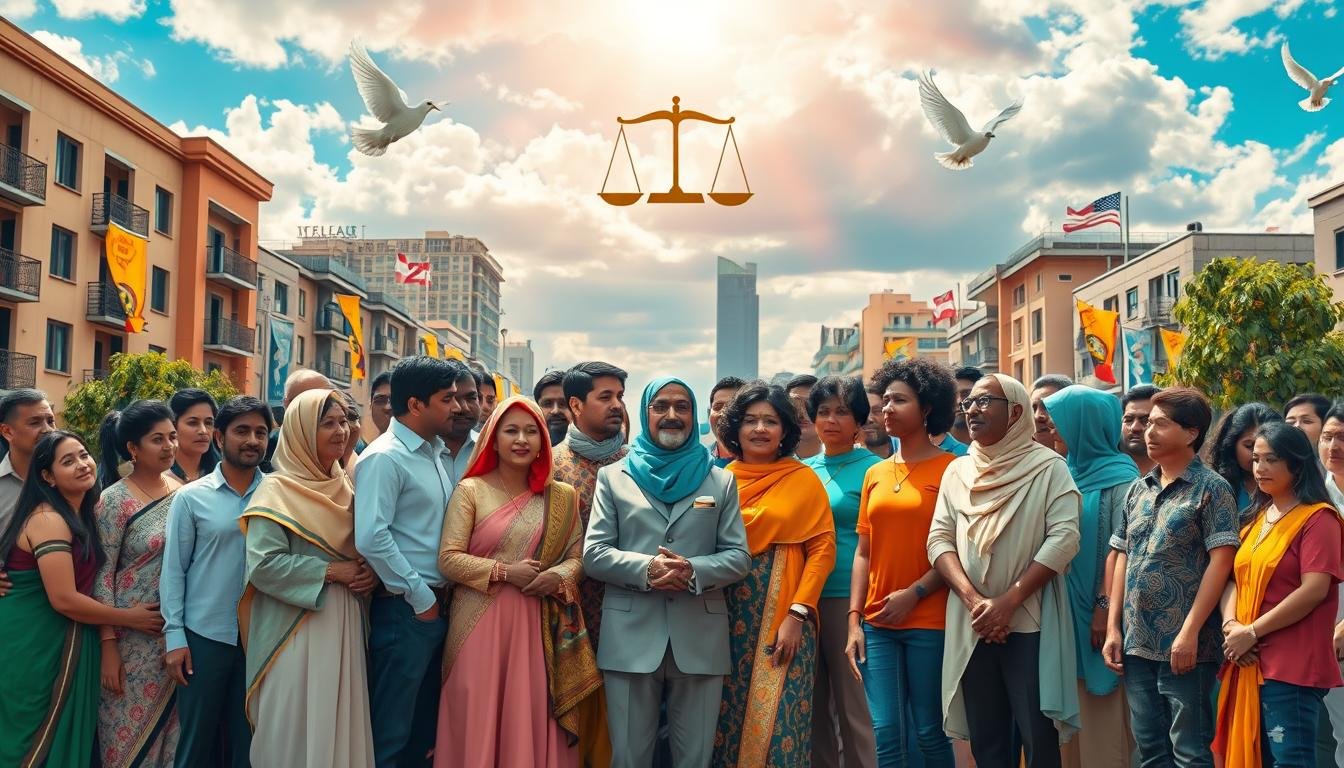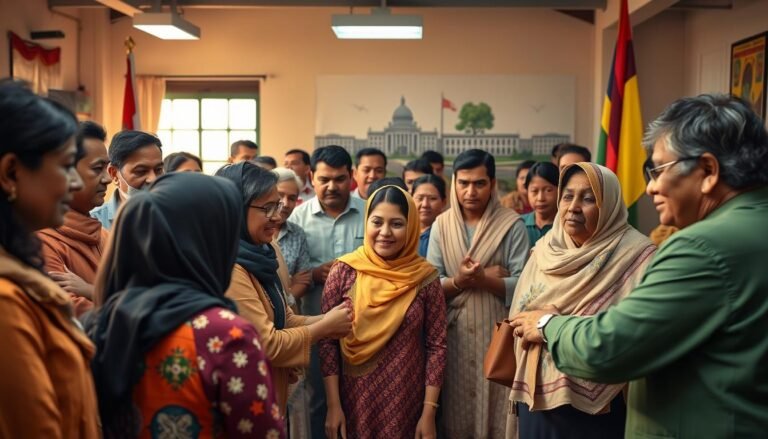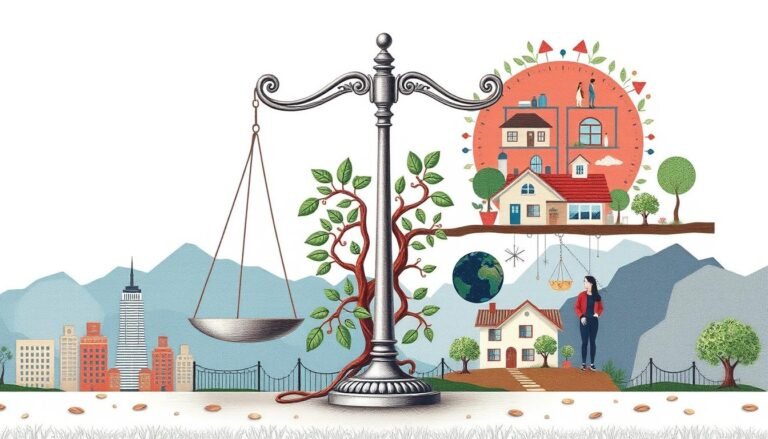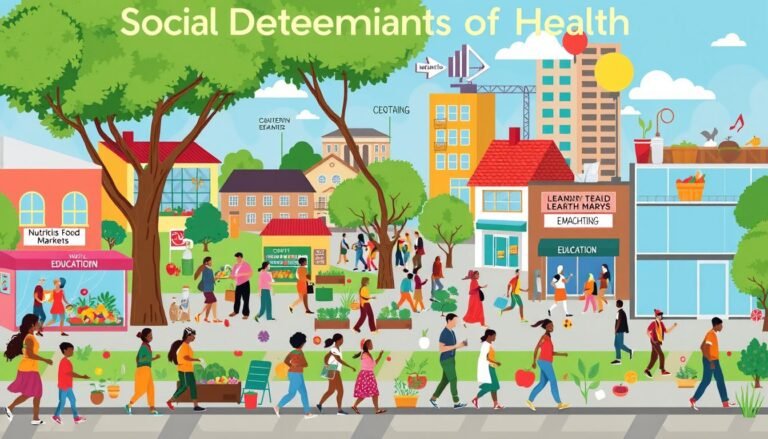Sociological Perspectives on Human Rights
In a world where human rights are often ignored, we wonder how to protect our basic freedoms. Sociological perspectives on human rights help us understand this complex issue. They look at how society affects our most basic rights.
Human rights have grown from centuries of religious, cultural, and philosophical ideas. The Universal Declaration of Human Rights in 1948 was a key moment. Since then, over 50 international groups have been set up to protect these rights.
Sociology gives us a special way to see human rights as a social issue. It looks at how we use our rights in everyday life and how society deals with different claims. This helps us understand the struggles of marginalized groups and the importance of social justice movements.
Sociological views highlight the many sides of human rights. They explain why some rights are accepted in some places but not others. They also show how globalization changes our view of universal freedoms.
Key Takeaways
- Human rights are shaped by societal norms and cultural contexts
- Sociology examines how rights are practiced in everyday life
- Social justice movements play a crucial role in advancing human rights
- Marginalized communities often face unique human rights challenges
- Globalization has a significant impact on human rights perspectives
- Understanding sociological perspectives can lead to more effective rights protection
Understanding Human Rights from a Sociological Standpoint
Human rights deeply shape our society. Sociologists see them as more than just ideas. They are social practices that are part of our everyday lives. This view gives us a deeper understanding of how rights change and work in communities.
Defining Human Rights in Sociological Terms
From a sociological view, human rights are not just laws. They come from the norms and values of society. These rights are made real through places like schools, courts, and families. They show the ongoing fight for freedom and equality against global inequality.
The Evolution of Human Rights as a Social Construct
The history of human rights is long and complex. It goes back to ancient times and includes modern declarations. The Universal Declaration of Human Rights in 1948 was a big step forward. Since then, over 50 international groups have been set up to protect these rights.
Interconnection between Sociology and Human Rights
Sociology is key to understanding human rights. It looks at how society affects these rights and deals with different claims. Scholars like Bryan Turner and Gideon Sjoberg have made big contributions. Their work shows us the social conditions that help human rights to work.
“Human rights are not just legal concepts, but social practices embedded in our daily lives.”
Cultural relativism makes it hard to apply human rights everywhere. It brings up questions about fitting rights in different societies. This shows the tricky balance between local traditions and global human rights standards.
Historical Development of Human Rights in Sociology
Early thinkers like Emile Durkheim, Karl Marx, and Max Weber doubted universal human rights at first. But as society changed, so did our understanding of rights. This led to a deeper appreciation for human rights in sociology.
As states grew and became more powerful, human rights became a way for the weak to stand up against the strong. They became a call for equality and making sure everyone is included.
Social justice movements were key in shaping human rights. In 1922, a school trustee in Victoria spoke out against segregating Asian students. He argued it went against British justice and Christian values. This shows how civil liberties were becoming important in society.
Today, human rights cover more than just political and civil freedoms. They include things like environmental rights and access to the internet. Gender equality is also a big part of human rights, seen in documents like Canada’s Charter of Rights and Freedoms.
“Rights have historically been a rallying cry for those committed to equality and inclusivity.”
After World War II, the term “human rights” became more popular. This was thanks to the United Nations being formed in 1945 and the Universal Declaration of Human Rights in 1948. This move shifted focus from “natural rights” to universal human rights focused on freedom and equality.
Key Sociological Theories and Human Rights
Sociological views on human rights give us deep insights into how we see and apply these basic rights. There are three main theories that help us understand human rights issues.
Functionalism and Human Rights
Functionalism sees human rights as key for keeping society stable. It believes that rights play a role in keeping society in order. For instance, the right to education helps create a skilled workforce, boosting the economy and social unity.
Conflict Theory and Human Rights
Conflict theory looks at how power and rights are not equal. It says that those in power often keep their advantages, leaving others behind. This view shows how groups can push for change to make rights fairer.
| Theory | View on Human Rights | Key Focus |
|---|---|---|
| Functionalism | Essential for social stability | Societal order and integration |
| Conflict Theory | Tool for addressing power imbalances | Social change and equity |
| Symbolic Interactionism | Shaped by individual interpretations | Everyday interactions and meanings |
Symbolic Interactionism and Human Rights
Symbolic interactionism looks at how we see and act on human rights in our daily lives. It says our understanding of rights comes from how we interact with others and our culture. It points out the importance of language and symbols in shaping our rights.
These theories offer different ways to see human rights. They range from looking at society’s needs to how power affects us and how we see things. By using these views, we can better understand how human rights work in our complex social world.
Sociological Perspectives on Human Rights
Sociology sheds light on human rights, seeing them as social actions shaped by culture and society. It shows how individual rights and group values interact.
Human Rights as a Social Practice
Human rights are more than legal ideas; they’re part of our everyday life. They change with society and culture. For instance, Canada values civil and political freedoms more than economic and social ones, showing its history and values.
Society’s Role in Shaping Human Rights
Society is key in setting and upholding human rights. In Canada, the Charter of Rights and Freedoms protects multiculturalism, gender equality, and Indigenous rights. This shows how society’s beliefs shape human rights.
Cultural Relativism vs. Universalism
The debate between cultural relativism and universal human rights is important. Universal standards aim to protect everyone, but cultural relativism suggests respecting different cultures. This issue affects global equality and social justice, as we try to balance rights with cultural differences.
| Approach | Perspective on Human Rights |
|---|---|
| Natural Law | Rights are inherent and universal |
| Historical Law | Rights evolve through historical processes |
| Positivist Law | Rights are defined by legal systems |
| Marxist Law | Rights reflect class struggles |
| Social Science Law | Rights are social constructs |
Sociological views on human rights offer a deep look at how rights are seen, used, and debated in various societies. By looking at human rights this way, we learn a lot about global inequality and the fight for social justice.
Human Rights and Social Institutions
Social institutions are key in protecting human rights. They include schools, courts, hospitals, and government groups. These places make sure civil liberties are respected.
Schools teach about gender equality and racial discrimination. This helps students know their rights and duties. Courts make sure laws protect everyone’s rights fairly.
Hospitals are also vital in defending human rights. They give everyone equal access to healthcare. This supports the right to health for everyone.
Government groups make policies that support civil liberties. They work to stop racial discrimination and help gender equality. Their efforts make a society where all rights are valued.
“Social institutions are the foundation upon which human rights are built and protected in our society.”
Knowing how these institutions work shows us how rights are protected and sometimes broken. It’s crucial to keep improving these systems. This way, we can protect human rights for everyone.
The Role of Social Movements in Advancing Human Rights
Social justice movements have changed human rights worldwide. They make sure more people can take part in making political decisions. They also stand up for groups that are often ignored.
Case Studies of Successful Human Rights Movements
The Arab Spring is a key example of how social movements can make a difference. In 2011, Tunisia’s people led a big change. This movement inspired others in Egypt, where hundreds of thousands came out to protest.
They demanded change, and after a lot of pressure, President Hosni Mubarak stepped down after 30 years.
Strategies Employed by Social Activists
Activists use many ways to push for human rights. They work with big groups like the United Nations on issues like gender equality and holding companies accountable. These meetings help connect different groups and share their stories.
Challenges Faced by Human Rights Movements
Human rights movements face big challenges. They often meet resistance from powerful governments and have limited resources. It’s hard to tackle different kinds of discrimination at the same time.
But, despite these problems, social movements have made a big difference. They’ve led to better human rights in many places. Social movements have always been key in making big changes in society.
They keep fighting for indigenous rights and building a world where human rights are respected everywhere. They do this through international agreements and groups.
Globalization and Its Impact on Human Rights
Globalization has changed how we see human rights around the world. It connects countries in ways both good and bad. Now, we see a big debate between universal rights and respecting local cultures.
Global inequality is a big issue today. More jobs move to developing countries, creating complex economic ties. This has led to the creation of Export Processing Zones for companies looking for cheap labor.
- Big companies now have a big say in areas once controlled by governments
- Structural Adjustment Programs cut down on government spending and social services
- The “There Is No Alternative” argument pushes developing countries to adopt market reforms
- Economic changes increase debt and poverty in poor countries
International groups like the United Nations are key in setting human rights standards. The United Nations Convention on the Rights of the Child shows how countries work together to protect kids. Religious groups, like the United Methodist Church, also push for human rights and stop exploitation.
| Aspect | Impact on Human Rights |
|---|---|
| Economic Shift | Race to the bottom in wages and working conditions |
| Global Institutions | Promotion of liberalization and market-oriented reforms |
| National Sovereignty | Encroachment by transnational companies |
| Social Services | Cuts due to Structural Adjustment Programs |
As globalization keeps changing, we must find a way to grow the economy without hurting human rights. Social justice groups face a tough challenge. They need to make sure progress doesn’t mean losing our dignity and well-being.
Contemporary Issues in Human Rights from a Sociological Perspective
Sociologists look into pressing human rights issues with different views. These views show how social structures and personal experiences mix to shape human rights. They help us understand the complex nature of these issues.
Gender equality and women’s rights
Gender equality is a big issue today. In the US, eating disorders hit women harder, showing problems with body image and social pressure. Title IX in 1972 was a big step towards fighting gender bias in schools. But, we still face hurdles in reaching true equality.
Racial discrimination and minority rights
The battle against racial discrimination is ongoing. The Civil Rights Act of 1964 banned discrimination based on race and other factors. But, racial gaps still exist, especially in education. Schools in cities often have too many students and lack resources, hurting minority students’ learning.
Economic inequality and social justice
Economic inequality is a big human rights issue. The 2008 economic crisis led to more unemployment, showing deep-seated problems. Sociologists like William Ryan say poverty and joblessness come from unfair social structures, not just personal issues. To fix this, we need to understand society better and fight for social justice.
Source Links
- Rights: Sociological Perspectives
- Sociological aspects of human rights – iPleaders
- Sociological Approach to Human Rights Research
- The Sociological Discourse on Human Rights: Lessons from the Sociology of Law
- Human rights | Definition, Examples, Importance, & Facts
- Sociology, Human Rights, and the World Social Forum
- Social Justice and Sociological Theory
- 1.3 Theoretical Perspectives in Sociology – Introduction to Sociology 3e | OpenStax
- Handbook of Sociology and Human Rights
- Social Sciences
- 8 Sociological Theory of Rights
- GBCS
- Globalization and its Impact on Human Rights, by Mathews George Chunakara – Religion Online
- 1.2 Sociological Perspectives on Social Problems
- 1.2 Sociological Perspectives on Social Problems
- Understanding Civil Rights in Sociology







